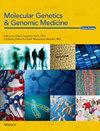在一名患有先天性鱼鳞状红皮病的中国患者中发现了复合杂合ABCA12变体:推进基因型与表型的相关性及文献综述
IF 1.5
4区 医学
Q4 GENETICS & HEREDITY
引用次数: 0
摘要
背景鱼鳞病是一种常见的角化性皮肤病,具有高度的临床、病因和遗传异质性。非综合征遗传性鱼鳞病有四种类型,其中常染色体隐性遗传先天性鱼鳞病(ARCI)是一组异质性隐性孟德尔疾病。ARCI表现出不同的表型,ABCA12致病变体已被证明可导致复杂的ARCI表型,包括哈勒奎鱼鳞病(HI)、板层状鱼鳞病(LI)和先天性鱼鳞状红皮病(CIE)。外显子组测序与桑格测序相结合,以确诊并确定致病变体。研究人员使用多个软件程序进行了硅预测,并根据 ACMG 指南对确定的变异进行了解释。结果发现了ABCA12复合杂合变体[c.5381+1G>A和c.5485G>C (p.Asp1829His)](NM_173076)。据预测,c.5381+1G>A 会影响 ABCA12 mRNA 的剪接,而 Asp1829 在不同物种中高度保守。硅学分析表明,这两个变异是造成患者表型的原因。基因型与表型的相关性分析表明,ABCA12的双侧缺失变异和/或外显子/氨基酸缺失是导致HI的最常见原因。结论ABCA12复合杂合子变异导致患者出现CIE表型。ABCA12致病变体的范围有所扩大。基因型与表型的相关性分析提供了详细的证据,可用于未来的产前诊断,并为ABCA12相关ARCI患者提供遗传咨询。本文章由计算机程序翻译,如有差异,请以英文原文为准。
Compound heterozygous ABCA12 variants identified in a Chinese patient with congenital ichthyosiform erythroderma: Advancing genotype–phenotype correlations and literature review
BackgroundIchthyosis is a common keratotic skin disease with high clinical, etiological and genetic heterogeneity. There are four types of non‐syndromic hereditary ichthyoses, among which autosomal recessive congenital ichthyosis (ARCI) is a heterogeneous group of recessive Mendelian disorders. ARCI present with different phenotypes and ABCA12 pathogenic variants have been shown to cause complex ARCI phenotypes, including harlequin ichthyosis (HI), lamellar ichthyosis (LI) and congenital ichthyosiform erythroderma (CIE).MethodsA sporadic male patient, clinically diagnosed with CIE, was enrolled in this study. Exome sequencing was combined with Sanger sequencing to confirm the diagnosis and identify the pathogenic variants. In silico predictions were made using multiple software programs, and the identified variants were interpreted using the ACMG guidelines. A review of all literature reported ABCA12 variants was performed to explore genotype–phenotype correlations.ResultsCompound heterozygous ABCA12 variants [c.5381+1G>A and c.5485G>C (p.Asp1829His)] (NM_173076) were identified. The two variants were not detected in the public database. c.5381+1G>A is predicted to affect ABCA12 mRNA splicing and Asp1829 is highly conserved among various species. In silico analysis suggested that these two variants were responsible for the phenotype of the patient. Genotype–phenotype correlation analysis showed that biallelic truncation variants and/or exon/amino acid deletions in ABCA12 are the most common causes of HI. Biallelic missense variants are most common in LI and CIE.ConclusionsThe compound heterozygous ABCA12 variants caused the CIE phenotype observed in the patient. The spectrum of ABCA12 pathogenic variants were broaden. Genotype–phenotype correlation analysis provided detailed evidence which can be used in future prenatal diagnosis and can inform the need for genetic counselling for patients with ABCA12 ‐related ARCIs.
求助全文
通过发布文献求助,成功后即可免费获取论文全文。
去求助
来源期刊

Molecular Genetics & Genomic Medicine
Biochemistry, Genetics and Molecular Biology-Genetics
CiteScore
4.20
自引率
0.00%
发文量
241
审稿时长
14 weeks
期刊介绍:
Molecular Genetics & Genomic Medicine is a peer-reviewed journal for rapid dissemination of quality research related to the dynamically developing areas of human, molecular and medical genetics. The journal publishes original research articles covering findings in phenotypic, molecular, biological, and genomic aspects of genomic variation, inherited disorders and birth defects. The broad publishing spectrum of Molecular Genetics & Genomic Medicine includes rare and common disorders from diagnosis to treatment. Examples of appropriate articles include reports of novel disease genes, functional studies of genetic variants, in-depth genotype-phenotype studies, genomic analysis of inherited disorders, molecular diagnostic methods, medical bioinformatics, ethical, legal, and social implications (ELSI), and approaches to clinical diagnosis. Molecular Genetics & Genomic Medicine provides a scientific home for next generation sequencing studies of rare and common disorders, which will make research in this fascinating area easily and rapidly accessible to the scientific community. This will serve as the basis for translating next generation sequencing studies into individualized diagnostics and therapeutics, for day-to-day medical care.
Molecular Genetics & Genomic Medicine publishes original research articles, reviews, and research methods papers, along with invited editorials and commentaries. Original research papers must report well-conducted research with conclusions supported by the data presented.
 求助内容:
求助内容: 应助结果提醒方式:
应助结果提醒方式:


